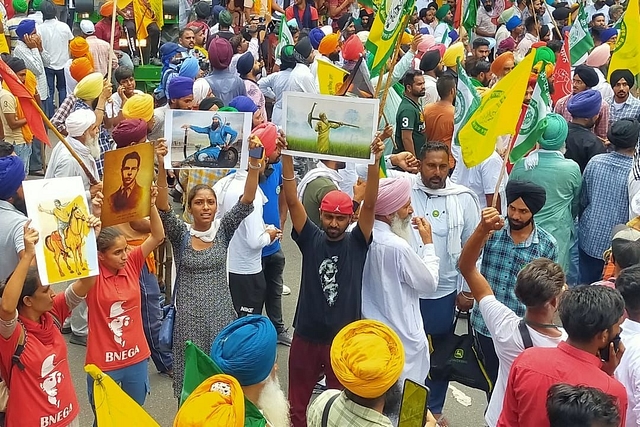
Explained: Amid Fears Of Third Wave, Farmer Protestors Plan More Rallies Rejecting Centre’s Outreach, Why?
The protesters have already rejected the government’s offer to amend provisions related to the fee structure notified in the APMCs; stricter provisions to safeguard farmers’ land rights; strengthening of notified markets; and a guarantee on minimum support prices (MSPs). It is clear that there are factors at play that are stopping the farmer leaders from meeting in the middle.
Those protesting the three farm reform laws celebrated 26 June (Saturday) as the "Save Agriculture, Save Democracy Day" to mark the seven-month completion of the protests.
Certain farmer groups have been protesting since 26 November last year against the three newly enacted farm laws — Farmers' Produce Trade and Commerce (Promotion and Facilitation) Act, 2020; the Farmers Empowerment and Protection) Agreement on Price Assurance and Farm Services Act 2020 and the Essential Commodities (Amendment) Act, 2020.
They have been camping on the outskirts of national capital Delhi at the three borders — Ghazipur, Singhu, and Tikri — demanding a repeal of the laws and as well as a legal guarantee on minimum support prices for the crops.
Despite repeated assurances by the government that there has been no change in MSP mechanism due to the laws and the MSP will continue as it has been for years, the farmer protesters have refused to budge.
On 26 June, the farmers announced a tractor rally in the national capital and that they will submit memorandums to Governors across the country against the laws. Farmers in Punjab and Haryana also took out protest marches, heading for Raj Bhavan.
Stringent security measures consisting of a heavy police deployment and barricades were employed to avoid any law and order situation. The Delhi Metro had shut its three main stations on the Yellow Line for four hours. The heavy barricading resulted in hours-long jams.
Security was a major concern as intelligence agencies had alerted that Pakistan-based Inter-Services Intelligence (ISI) proxies planned to use the proposed farmers' protests to attacks and instigate the deployed forces.
The same day Union Agriculture Minister Narendra Singh Tomar reiterated that government was willing to discuss all provisions of the farm reform laws, and redress farmers' grievances.
“I want to tell all the farmers union people that they should end their agitation. The Government of India is also ready to discuss and redress any provision of law," he tweeted. However, till now, the 11 round of talks chaired by him with the farmers have remained inconclusive.
The first round of talks with farmers was held in December last year.
Bhartiya Kisan Union (BKU) leader Rakesh Tikait, leading the protest at Ghazipur border, said that they would hold two more rallies — one a tractor rally on 9 July, which is scheduled to reach Singhu border the next day, to be joined by farmers from Shamli and Bhagpat in Uttar Pradesh.
The second rally will be organised on 24 July, departing from Bijnor, reaching Ghazipur the next day after a night halt at Meerut. Tikait said that the protests will be peaceful and continue as long as needed.
Also read: Data Story: Did The 'Farmers' Protest' Cause The Second Wave Of Covid-19 In India?
Samyukt Kisan Morcha (SKM), the umbrella body of farmer bodies spearheading the agitation, said it will send a memorandum from all over India to the President on "anguish and indignation" of the farmers. It also announced that Monday (28 June), will be marked as "Kisan Mazdoor Bhaichara Diwas" at Sunehra protest site near the Haryana-Rajasthan border. It also said that as an expression of solidarity, one rally is also being planned in Massachusetts, United States.
In January this year, Tikait said that farmers prepared to protest till May 2024, the year of the next Lok Sabha elections. Tikait, a Jat leader, has also made clear that the 2022 assembly elections (Uttar Pradesh, Punjab both are going to elections) are his target. He has been meeting different Opposition leaders. Almost all political parties except BJP have supported the agitation in the two states.
One might wonder how farmer protests, with seemingly low reverberation from the wider sections of society, have been going on for seven months.
Pramod Kumar states, in an Indian Express article, that the movement has survived because a well-entrenched class, the class which has ruled Punjab since the mid-60s in the post-Green Revolution phase, supports it. The movement, therefore, has at its disposal an abundance of human and material resources.
Kumar says that the movement has enormous support among retired and even serving civil servants, teachers, students, civil society activists, artists and professionals.
The current protests are about more than farmers’ issues, and its leaders have bigger political ambitions. While one can see the current farmer protests as the agricultural landed class trying to protect the economic as well as socio-cultural privileges that come from land-owning, it is also true that diverse forces with very different agendas have joined the current farmer protests.
While this may ensure a longer life for the protests, it also means a risk of sidelining the core issue — the welfare of the farmers.
Many scholars, typically critical of the current ruling dispensation, have come out in the support of the farm laws, likening them to the path-breaking 1991 reforms. They say that the new laws, by bringing market efficiency in the agriculture sector, can boost farmer incomes and reduce food prices.
It is also important to note that the farmer protesters have already rejected the government’s offer to amend provisions related to the fee structure notified in the Agricultural Produce Market Committees (APMCs); stricter provisions to safeguard farmers’ land rights; strengthening of notified markets; and a guarantee on minimum support prices (MSPs).
It is clear that there are factors at play that are stopping the farmer leaders from meeting in the middle. What impact the protests will have on the upcoming elections — that remains to be seen.